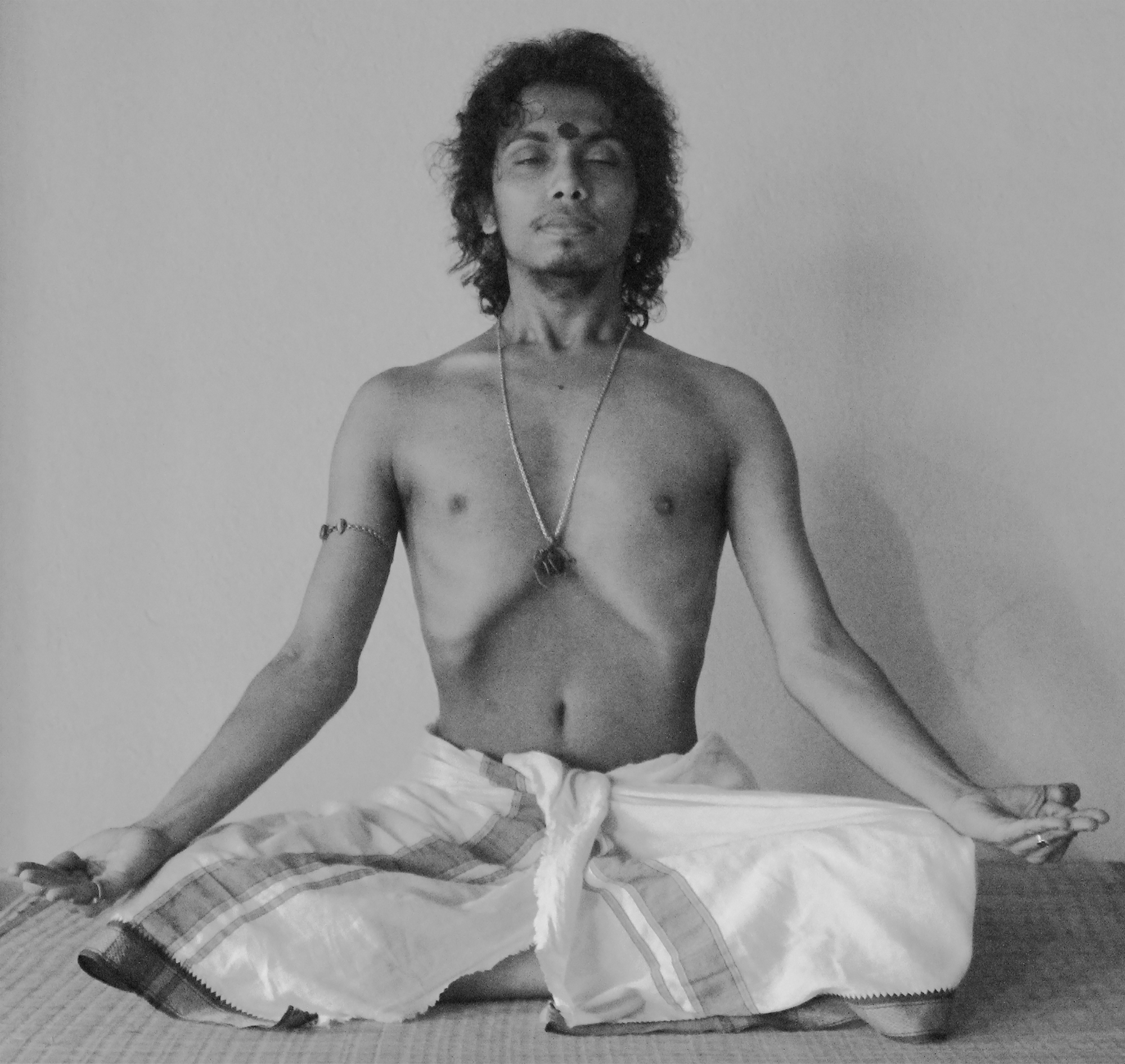NrityaChuramani Rahul Dev Mondal ( Assistant Professor, Rabindra Bharati University, Department of Dance )

1.1 Introduction about Yoga / Yoga Definition
Yoga is essentially a spiritual discipline based on an extremely subtle science that focuses on bringing harmony between mind and body. It is an art and science of healthy living. The word ‘Yoga’ is derived from the Sanskrit root ‘Yuj’, meaning ‘to Join’ or ‘to yoke’ or ‘to unite’. As per yogic scriptures, the practice of yoga leads to the union of individual consciousness with that of the universal consciousness, indicating a perfect harmony between the mind and body, man and nature. According to modern scientists, everything in the universe is just a manifestation of the same quantum firmament. One who experiences this oneness of existence is said to be in yoga and is termed as a yogi, having attained to a state of freedom referred to as ‘Mukti’, ‘nirvana’ or moksha’. Thus the aim of yoga is self-realization, to overcome all kinds of sufferings leading to ‘the state of liberation’ (Moksha) or ‘freedom’ (Kaivalya). Living with freedom from all walks of life, health, and harmony shall be the main objectives of yoga practice.
1.2 Introduction about Astanga Yoga

In Sanskrit “Ashta + anga” is ashtanga. “Ashta” means Eight and “Anga” is limbs so it means Eight Limb path, Ashtanga yoga is based on Yoga Philosophy of Patanjali. The asanas, Pranayamas, or the Dharana which we have studied earlier or the yam and niyam are based on the Yoga Sutras of Patanjali. Hence, we will acquaint ourselves with the fundamentals as stated by Patanjali first.
Ashtanga Yoga is the eight-limbed path of conscious living and spiritual practice that guides one towards Self-Knowledge, liberation, and cessation of personal suffering. It is presented in the Yoga Sutras which was compiled around 200 BCE by the great sage Patanjali.
1.3 The Eight Limbs are as follows:
1. Yama – Restraints
Ahimsa – non-violence
Satya – truthfulness
Asteya – non-stealing
Brahmacharya – sublimating sexual energy
Aparigraha – non greed
2. Niyama – Observances
Shaucha – purity within & without
Santosha – contentment
Tapas – discipline
Svadyaya – Self / scriptural study
Ishvarapranidana – surrender
3. Asana – Posture
4. Pranayama – Control of breath and prana
5. Pratyahara – Directing the senses inwards
6. Dharana – Concentration
7. Dhyana – Meditation
8. Samadhi – Unified consciousness yoga
1.4 Chitta vritti nirodhah |
This means that yoga means controlling the thought waves of the mind. The thoughts, feelings, emotions arising in the mind are vrittis (nature), which should be controlled. This is called yoga. The broader perspective is expected and the word Chitta here means Individual consciousness, which covers all states conscious, sub conscious and unconscious.
While trying to control the vrittis (thoughts, emotions, feelings), certain disturbances are created which stop or divert the growth. Patanjali has addressed them as “Antaray(Disturbances) creating chitta vikshepa”. These are described as under :
Vyadhistyan sanshay pramad alasya virati bhranti darshanalabdha bhoomi katvanavsthitatvani chittavikshepasteantarayah |

1.5 Discus about Physical ,Mental , Social & Spiritual Aspects in Astanga Yoga :
Physical aspect – The important benefit of yoga is physical well being. The aging process, which is largely an artificial condition, caused mainly by autointoxication or self-poisoning, can be slowed down by practicing yoga. By keeping the body clean, flexible, and well-lubricated we can significantly reduce the catabolic process of cell deterioration. To get the maximum benefits of yoga one has to combine the practices of yogasanas, pranayama, and meditation. Regular practice of asanas, pranayama, and meditation can help such diverse ailments such as diabetes, blood pressure, digestive disorders, arthritis, varicose veins, and heart conditions. Laboratory tests have proved the yogi’s increased abilities of consciously controlling autonomic or involuntary functions, such as temperature, heartbeat, and blood pressure. Research into the effect of yogic practices on HIV is currently underway with promising results. According to medical scientists, yoga therapy is successful because of the balance created in the nervous and endocrine systems which directly influences all the other systems and organs of the body. Yoga acts both as a curative and preventive therapy. The very essence of yoga lies in attaining mental peace, improved concentration powers, a relaxed state of living, and harmony in relationships.

Mental aspect: Many people who practice yoga speak of freeing the mind from mental disturbances ‘calming the spirit’ or ‘steadying the mind: Reduction of nervousness, irritability and confusion, depression and mental fatigue and some of the benefits experienced. Yoga is said to result in the reduction of a variety of mental ills. These may range all the way from vague feelings of frustration, persecution, insecurity, on the one hand, to acute and specific types of insanity, on the other. Yoga helps us to be relaxed and handle stressful situations more easily. It teaches us how to quiet the mind so we can focus our energy on where we want to go into a difficult yoga pose. It always encourages positive thoughts and self-acceptance.
Social aspect: Yoga impresses upon discarding violence and corruption which are the polluters of social life. Violence is intentional persecution whereas Ahimsa is its avoidance. Ahimsa is not the repudiation of ‘otherness’ but it is the sacrifice of that persecution which can be held valid in the presence of the other. Likewise, the truth being avoidance of deceit through gullible words is the execution of altruism through valid and secret words. Asteya in the form of avoidance of others’ possession and Aparigraha in the form of no amassing of the riches creates a social balance from an economic point of view. Out of these, the former indicates the wrongs of consumption without producing anything and the latter declares the hoarding, exploitation, and artificiality created scarcity to create an imbalance in the social life is improper. Thus these principles educate us to ‘produce more and accumulate less’ or ‘Maximum production and minimum profit’. Maitri, Karuna, Mriduta, and Upeksha which have been accepted in Patanjali’s yoga, can be implemented only in the social context and these feelings gradually soften the behavior towards commonly hard, hit people, progressive individuals and the enemies.
Spiritual aspect – Yoga builds awareness of our body, feelings, the world around us, the needs of others. It promotes interdependence between mind, body, and spirit. Apart from the physical and psychological benefits of yoga the major impact of yoga on spiritual energy, self-consciousness, and mindfulness. Mindfulness refers to focusing our attention on what we are experiencing in the present movement without judging our self. The scientist has found that by regular practicing of Dhyana many parts of the brain got activated and release the neurotransmitters enzymes which increase mindfulness and mind awareness.
1.6Conclusion :
Yoga is a subject that can be looked at intellectually and some useful and beneficial ideas imbibed. Yoga can be imbibed by adopting certain attitudes which alter the nature of the samskaras. Yoga can be imbibed by living in an ashram environment and trying to be aware of the physical, mental, and spiritual dimensions at the same time. Yoga can be learned in a classroom environment as science, as psychology, as an applied subject, with the aim of providing new understanding and insight into the life process, into areas where karmas are performed, into areas which shape the inner being in terms of awareness, inner development, the experience of harmony or balance, eventually culminating in the experience of samadhi and the fullness of wisdom, prajna.
A state of yoga can be attained when wisdom is established. This has been the vision of the seers who brought forth Satyananda yoga. This yoga is presented in the form of a lifestyle, understanding and attitude. It is presented as an integral part of the day-to-day activities, of understanding one’s dharma and kartavya, obligations and responsibilities, and trying to see the whole world as one slowly evolving and unfolding unit.
Bibliography :
- Gitananda Giri Swami, Ashtanga Yoga of Patanjali, Satya Press, Ananda Ashram, Pondicherry
- Gitananda Giri Swami. Mudras. Satya Press, Ananda Ashram, Pondichery.1975
- Gitananda Giri Swami. Yoga: Step By Step, Satya Press, Ananda Ashram, Pondicherry. 1970
- Hinduism Today July 1992.Yogi Playwright Infusing Indian Theatre With More Atma and Altruism.
*********************************************
